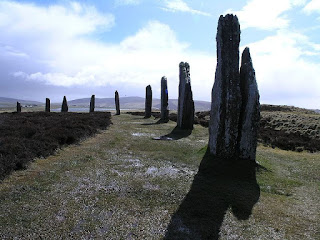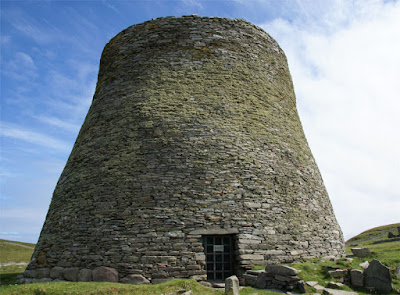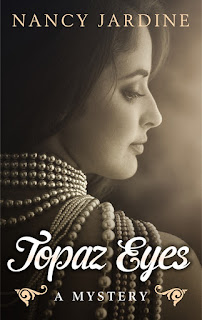Happy Saturday wishes to you!
The sun is shining for the third day in a row and it's nice and warm which for the north east of Scotland is pretty exciting. (it's not seriously hot, mind but at c.18 Deg C it's comfy) It makes me want to be at home lazing about and trying to write outside, battling the inevitable screen glare issue rather than being elsewhere. It makes me really appreciate having a home and garden to step into.
For these reasons, I'm re-blogging a post that I created for my slot last Wednesday (24th May) for the Writing Wranglers and Warriors blog. It is particularly apt. I think, since it's about ancient homes that were typical in Scotland some thousands of years ago. Mostly though the post is about a special kind of building that's almost exclusively found in Scotland. Yes, there are some examples in Ireland and in England but BROCHS are predominantly a Scottish ruin.
The title of this post is in my best Doric, the dialect of the north east of Scotland and translated means 'What is a broch about'? Was it a home? Or was it built for defence? Or did it serve another purpose?
Home Sweet Home…or was it?
You’ll find a multitude of sayings about ‘home’ on the
internet. These few are particularly useful for my topic today.
Home is where the
heart is. Pliny the Elder
He is happiest, be he
king or peasant, who finds peace in his home. Johann Wolfgang von Goethe
A man's home is his
castle. Proverb
 |
| Skara Brae 1986 |
We all know of the huge variety of domiciles that we could call
home, nowadays, but an assortment of architectural house styles wasn’t always
the norm.
As a hobby historian, I’m quite fascinated by the earliest
types of habitation and the effort it took to create them. Admittedly, I’m more
familiar with the most primitive dwellings in my homeland area of Scotland than
those in other parts of the globe.
I’ve crawled into a reconstruction of a hunter gatherer’s hide, a very primitive covering made from sewn-together skins, but that’s not quite the same as walking
your way around someone’s home that’s connected to others, making them into a
tiny communal hamlet.
 |
| Skara Brae 1986 |
Probably the earliest type of collective living I’ve
wandered around were the homes of ‘Stone Age’ Neolithic people on the island of Orkney at Skara Brae. What remains of these stone dwellings is totally
remarkable, though only because they lay under sand dunes for millennia before
the wind and waves uncovered them in the mid 19th century.
At Skara Brae we
can envisage a day in the life of the people. The delineated areas of the homes
(minus original roofs) are easily visible as in a ‘bird’s eye view’. Their cupboards
are built into the wall, the fireplace is central and their sleeping cots are
blocked off with large slabs. There is even a built-in channel that is
essentially primitive drainage, as in for toilet use: functional but effective
buildings.
 |
| Ring of Brodgar |
Were the Skara Brae
houses fortified in any way? It doesn’t seem the case but there are some new
theories going around (resulting from recent excavation) that the nearby
timber/standing stone circles in the Orkney Isles may have had a community
aspect to their construction.
It’s now believed by some current archaeologists
that the earliest of these stone henges pre-date that of Stonehenge in England and
that the culture of building such henges may have travelled southwards, rather
than northwards. Regardless of the direction of architectural influence, the
massive wooden and stone circles were most likely built for religious
observance and of people to congregate for positive reasons without the need
for defence from outside entities, as in human raiders. In the Orkneys some
archaeologists now think there was a religious community living alongside the
henge monument.
 |
| Celtic Roundhouse Wikimedia Commons |
Skip forward a couple of thousand years and sail south to
mainland Scotland.
Archaeologists have to work much harder to find evidence of Neolithic, Bronze
and Iron Age ‘Home Sweet Home’. Mainly because wooden constructions last a lot less than those that were stone built.
The Bronze Age and Iron Age tribes seemed to have mainly
lived in hut circles, some with stone
foundations (probably where wood was less available) and the bulk in wooden ‘Celtic’ roundhouses. There’s
sufficient evidence around Scotland
for some variety in shape - some were oval though most were circular. Some individual roundhouse dwellings have been
found but it was more common for them to have been erected in a small cluster
situated near strip- field farms.
 |
| Crannog |
Crannog dwellings
built on wooden platforms are a fine example of Bronze and Iron Age living. By
the time crannogs were erected out
over the water of inland lochs they were probably fortifying themselves mainly
from marauding wild animals rather then marauding tribesmen. However, along
with the Bronze Age and Iron Age technology—effective weaponry in
particular—there came a greater need for tribespeople to defend themselves.
I’m currently very interested in a type of dwelling that’s
almost exclusively found in Scotland
– the Broch. But was it Home Sweet Home or not?
 |
| Dun Carloway - Wikimedia Commons |
Broch building is very difficult to define. Until recently not
enough time or effort was given to investigating this unique style of building.
Broch remains are found in southern Scotland
but the bulk are to be found in northern Scotland, the Western Isles, Orkney
and Shetland.
So how does a Broch differ from a Celtic roundhouse, or from
a crannog?
A Broch is a massive drystone built hollow-walled tower.
Some of these towers were thought to have been as high as 50 feet with walls of
around 4 feet thick- like the Broch of
Mousa in Shetland. Staircases wind their way up the hollow wall structure
to give access to upper levels and some of the evidence shows there could have been
multiple platforms, circular balconies or partial floors, inside a broch.
 |
| Interior staircase Dun Carloway- Wikimedia Commons |
Many brochs are thought to be from the Neolithic period but
intriguingly others situated towards the south of Scotland have been dated to 1st
century AD, during the Roman occupation.
Brochs have no windows and only one low entrance way so the
interior would have been extremely dark. How damp they were inside, I don’t even
want to imagine! What the roofs were constructed of is a matter of
interpretation: possibly thatched like roundhouses. A corbelled stone roof is
thought to be less likely, though that would have been a remarkable feat of
engineering and the technique not unknown because Neolithic people used it in
structures like the Maes Howe
chambered cairn on Orkney.
 |
| Mousa, Shetland Isles - Wikimedia Commons |
Earliest archaeological thinking was that Brochs were built
as a defensive structure but that’s hard to believe since there were no windows
to give access for repelling invaders.
Some experts then thought they were
built more as a status symbol by the local chief to show his superiority in
the region. The broch at Mousa, Shetland is certainly impressive enough for that!
However, some recent archaeologists aren’t ruling out the
idea that people maybe ‘holed up’ in them like in a self-sufficient ‘siege’ when
invaders threatened the area, and that they normally lived outwith the broch in
some other form of dwelling house. I’m not sure I’d want to be inside one for
months on end.
The theories are all fascinating conjecture!
I’ve been following a Facebook page named the Caithness
Broch Project which has an aim of properly identifying the multitude of Brochs
that litter Caithness. They also intend to
build a replica Broch to satisfy the curiosity of tourists like me. I’m eagerly
waiting for that to be built so that I can pop up and visit it though that’s
likely to mean a 400 mile round trip for me.
What's your favourite
‘Home Sweet Home’?
Whatever you do today- enjoy! I'm doing more new writing and some gardening. See you later...
Slainthe!































